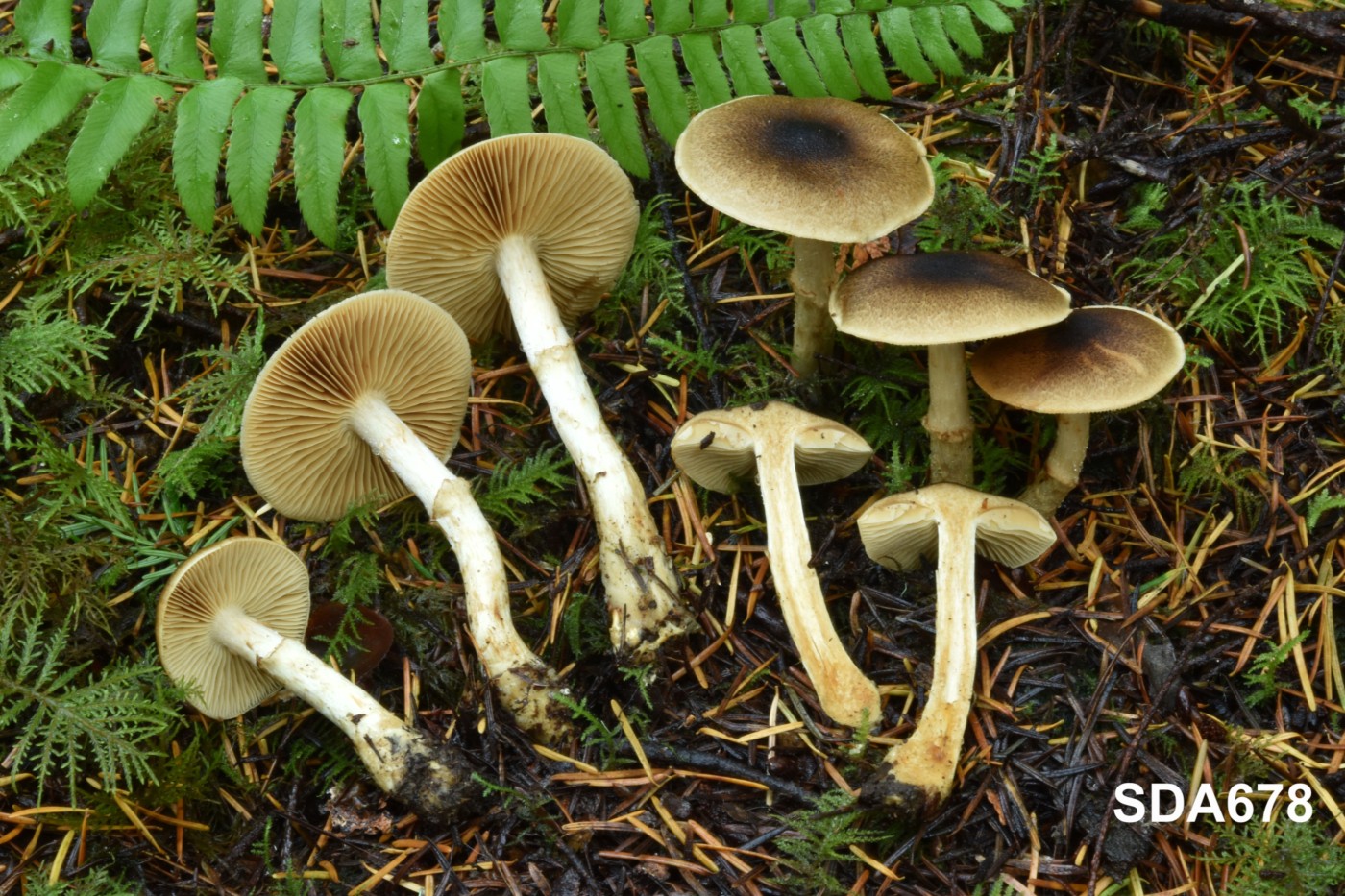Cortinarius clandestinus Kauffman, North American Flora 10 (5): 324 (1932) [MB#261040]
Holotype: MW009200
Description
Pileus 35-100 mm across, convex to upbonate or plane, with slight umbo remaining. Surface dry and tomentose covered with dark olive brown, blackish brown to olive brown fribrillose scales over the disc and to the margin when young, later with only disc densely scaley or fibrillose. The most recent review of Leprocybe also notes a non-scaly form. Base color yellow-olive, ochre yellow or greyish olive more or less visible below scales becoming more orange in age. Lamellae: cream, naples yellow, yellow-brown, faintly olivaceous yellow or yellow-brown. Although highly variable, never the rusty brown typical of mature Cortinarius fruitboies. Stipe: 27-100 mm long, 5-18 mm thick at apex, equal, tapered or clavate, creamy yellow to buff, base covered with greenish-yellow, yellow or creamy veil sometimes with well defined margin. Flesh: whitish to creamy sometimes browning or yellow-brown interior.
UV: Fresh specimens show vivid yellow UV reaction on gills and stipe surface but no reaction on cap, veil or stipe flesh.
Habitat and ecology: Widespread, occurring in both Eastern and Western USA in spring and in Western regions also during fall. Cortinarius clandestinus grows in a range of habitats from coastal to subalpine and with both conifer and mixed broadleaf-conifer forests.
Photographs
Discussion
Leprocybe are not super easy to differentiate so it is worth taking time with the paper (below) and using the key that is provided. In general, I would consider Cortinarius clandestinus when you find a Leprocybe with a black-scaley cap and cream to greenish-yellow tones. It one of few Leprocybe that fruit in Spring, making Spring ID easier. However, C.clandestinus may also fruit in fall so it’s not that easy!
To complicate matters, the degree of scaleyness is highly variable, from almost entirely black when young to lacking scales – making it important to do further examination to differentiate between C.clandestinus and species like Cortinarius atrotomentosus (which has UV+ reaction on the cap, where C.clandestinus cap is UV negative). Cortinarius parkeri – another Western montane spring Leprocybe – is smaller, lacks tomentose / scaley cap and has a distinctive volva of yellowish veil material around stipe base.
Habitat is also helpful in distinguishing Cortinarius clandestinus from similar Western species like Cortinarius fuscotomentosus (which occurs with broadleaf-conifer forests, has smaller spores and is, in my experience a larger and more robust species)
Sequences
Cortinarius in subgenus Leprocybe have relatively high intraspecific variation compared to most other Cortinarius species. The recent Leprocybe study (Ammirati et al, 2020) reported 1% intraspecific variation in the ITS region for C.clandestinus.
Holotype: MW009200
>SDA 639 Cortinarius clandestinus, WA
TTGCTGCTGGTTCTCTAGGGAGCATTGTGCACACTTGTCATTTTTATATCTCCACCTGTGCACCTTTTGTAGACCTGAATAATCTTTCTGACTGCAAGTCAGGTTTTGAGGAATTGGCTTTTAGTCTTTCCTTGCATTTTCAGGCCTATGTTTCTTTATATACTCCAATCTATCTTATAGAATGTAACAGGCCCTCTGTGCCTATAATTTATACAACTTTCAGCAACGGATCTCTTGGCTCTCGCATCGATGAAGAACGCAGCGAAATGCGATAAGTAATGTGAATTGCAGAATTCAGTGAATCATCGAATCTTTGAACGCACCTTGCGCTCCTTGGTATTCCGAGGAGCATGCCTGTTTGAGTGTCATTAATATATCAACTTCTTCAGCTTTTGCTTGTCGAGTGTTGGATGTGGGGGTGTTTTTGCTGGCCTTTTGAGGTCAGCTCCCCTGAAATGCATTAGCGGAACATTTTGTTGACTCTGTTCATTGGTGTGATAACTATCTACGCTATTGACGGATGAAGGCAGTTCAGCTCCTAACAGTCCATTGACTTGGACAACTTTTTCATTTAATGTGACCTCAAATCAGGTAGGACTACCCGCTGAACTTAAGCATATCAATAAGCGGAGGAAAAGAAACTAACAAGGATTCCCCTAGTAACTGCGAGTGAAGCGGGAAAAGCTCAAATTTAAAATCTGGCAGTCTTTGGC
References
Ammirati J, Liimatainen K, Bojantchev D, et al. 2021. Cortinarius subgenus Leprocybe, unexpected diversity and significant differences in species compositions between western and eastern North America. Persoonia 46: 216 – 239. https://doi.org/10.3767/persoonia.2021.46.08. Effectively published online: 27 May 2021
Ammirati, Joseph F., BarlowTess E., Seidl Michelle , T ., Ceska, Oldriska, Berbee, Mary, Harrower, Emma, and Liimatainen, Kare. 2012. Cortinarius parkeri, a new species from the Pacific Northwest of North America. Botany. 90(4): 327-335. https://doi.org/10.1139/b2012-003
Kauffman, Calvin Henry, North American Flora, vol. 10, 5, 1932.






Leave a comment